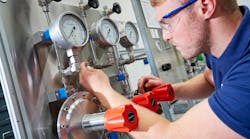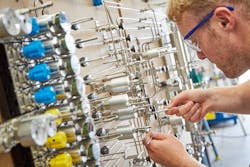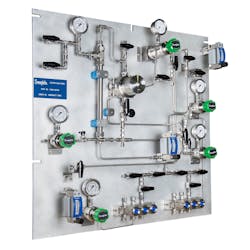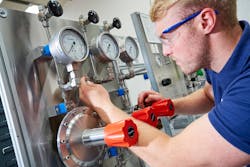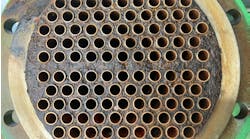Lower Maintenance Costs Through Modern Gas Panel Management
Reliability is essential in these systems because the gases are necessary for plants and laboratories to perform their basic functions. That’s why it’s important to fix any system deficiencies and make maintenance activities easier to perform. This may involve reconfiguring flow paths in your existing gas panels and using bendable tubing to reduce potential leak points and enable easier access to components. It may also include technicians tagging each significant component so they can quickly order a replacement when problems arise. Alternatively, a facility may choose to swap out its older systems with more modern gas pressure control panels, which typically require less maintenance than their predecessors. By adding such panels to systems, the cost of maintenance may be reduced significantly and directly affect a facility’s bottom line (Figure 1).
Simplifying Maintenance Through Optimized Design
In the past, gas panel designs have often located service-needy components in hard-to-reach enclosures or placed them behind pipes and tubes that must be taken apart to reach them. In such instances, maintenance technicians may struggle to understand how the gas panels work, which can interfere with their ability to provide appropriate maintenance. It can also increase the amount of time technicians must spend on panel maintenance that could be devoted to other areas in the plant.
Additionally, gas supplies must be curtailed to the location where service is being done, which leads to unplanned – and often unnecessary – downtime. Stopping production and testing to perform maintenance on gas panels is costly and can hurt facilities’ profitability.In contrast, modern gas panels are designed with maintenance in mind (Figure 2). Frequently serviced components like regulators and pressure valves are easily visible to technicians and appropriately labeled so no guesswork is involved. Modern gas panels are built modularly, which means technicians can work on specific components of the panel without taking it out of service (Figure 3).
While a simple plug-and-play replacement with a new gas panel may be the most efficient fix for a hard-to-service legacy panel, facilities also have the option to reconfigure their existing panels to make maintenance easier. As an example, technicians may reroute tubing or use flexible hoses to enable easier access to other components. Such actions may be a more cost-effective approach when various panel components are still in good working condition with a long service life anticipated ahead. For example, if you’ve recently replaced a regulator in an older panel, you may prefer to make other adjustments to make the panel easier to operate, rather than take that regulator out of service just to replace it with a different one housed in a preassembled gas panel.
Reducing Leaks Through Proper Tube Fittings
Traditional threaded connections can be difficult to maintain and reassemble, which is why most facilities use tube fittings instead. They are sturdier and more effective at reducing small, imperceptible leaks that could cost facilities money and safety if not stopped promptly.
For example, a common gas like nitrogen that is used to perform many functions in laboratories, refineries and other facilities may not pose an immediate threat to employees. Over time, however, the leak could prove to be costly. Now multiply one leak by the number of tubes that carry the gas around the facility, and you will understand how expensive it is to pay for gas that escapes the system through poor tubing connections. Gases that cost more money than nitrogen illustrate how critical it is to find and correct such leaks.Searching for small leaks across an entire system cannot always be a priority at a facility because chemical or processing plants are complicated ecosystems with many competing priorities. Some priorities may supplant leaks on any given day. To prevent as many leaks as possible, facility operators should purchase high-quality tube fittings to provide reliable, leak-tight performance over the life of the system.
Choosing the Right Components Is Vital
If your gas panels and distribution systems are constructed of high-quality individual components, maintenance-related labor costs may be reduced – and your system could run at peak performance.
Regulators are a prime example of a component that can have an outsized effect on how well your system functions. Tradition says these components should be replaced every five years with a well-designed system. Most maintenance technicians would not question this conventional wisdom because changing regulators every five years feels like the right amount of time necessary to prevent performance issues. Not all regulators are created equal, however. For the best results, consider using regulators that have been subjected to millions of testing cycles and have the potential to last as long as the gas distribution system will be operating.